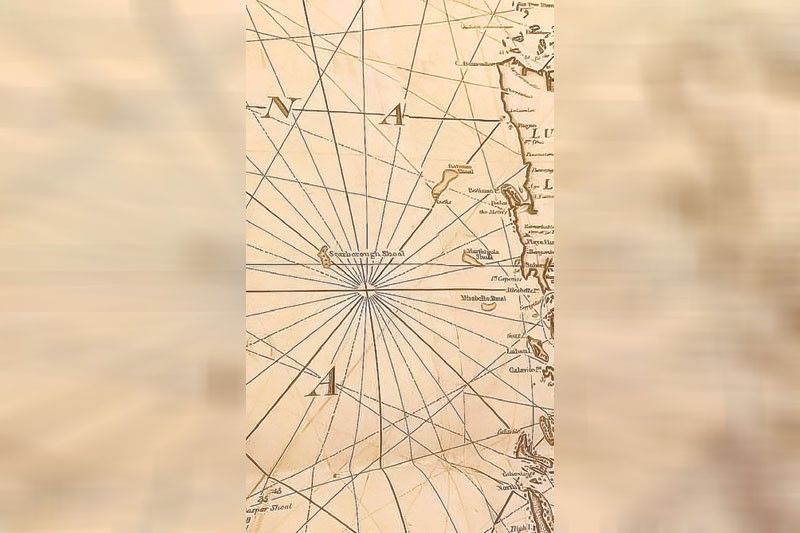
which was named after the British ship that struck the reef.
Scarborough 1st appeared on maps of Philippine waters in 1750s
MANILA, Philippines — On the night of Sept. 12, 1748 the British East India Co. ship Scarborough struck the now-famous reef of the same name while on its way from England to China.
As a result, the name “Scarborough Shoal” first appeared on maps of Philippine waters by English cartographers in the 1750s, according to research by a member of the Philippine Map Collectors Society.
However, the wreck of the Scarborough is not to be found in Philippine seas as it arrived safely back in England in June 1749.
The contentious Scarborough Shoal may thus be seen in William Heather’s 1799 “Chart of the China Seas,” an example of which was sold to great enthusiasm at the recent León Gallery Bibliophiles and Explorers Auction. It also appears in the Murillo Velarde map in his 1749 book under the name “Panacot,” which also went to auction last weekend successfully. Both terms refer to Bajo de Masinloc.
The vellum-covered Murillo Velarde tome (1749), containing a book-sized version of the famous 1734 map engraved by Nicolas de la Cruz Bagay and an engraving of the Virgin of Antipolo by Laureano Atlas, skyrocketed to P3.4 million (inclusive of buyer’s premium) while the Heather China Seas map took in P780,000.
These and other treasures were collected over a lifetime’s pursuit that spanned 70 years and three continents, the legendary array of books, maps and prints of the revered scholar Don Benito J. Legarda Jr. was one of 2023’s biggest blockbuster auctions, said León Gallery director Jaime Ponce de Leon. It smashed world records for Philippine books and prints – making it plain that the devotion to Filipino books and history is very much alive and well.
The entire collection topped P50 million and set a precedent in its genre. Titled “The Bibliophiles and Explorers Auction,” the sale also achieved the elusive white-glove status, or had 100 percent of its lots sold.
“It was the magic of the Legarda name, and the impeccable provenance of one of the country’s most beloved collectors that spelled the difference,” said Ponce de Leon. Coupled with the discovery of never-before-seen classics from the Legarda collection and the thrill of the chase in a competitive auction that attracted buyers worldwide, it was auction history in the making.
Dr. Jorge Mojarro, curator for books for León Gallery, contributed masterful essays on the volumes on offer in a lavish hardbound catalog that was in itself a sought-after survey of rare Philippine books; while founding member of the Philippine Map Collectors Society Alfredo Roca was curator for maps and prints.
Mojarro noted that many of the tomes were one of a handful known to be in existence in the world.
Treasures such as a compilation of the first 92 issues of the foundational periodical “La Solidaridad” sailed off at P7.8 million, inclusive of buyer’s premium. “Only Don Beniting could have painstakingly put this together,” Ponce de Leon said. The Soli, which inspired the founding of the Katipunan by Andres Bonifacio, is a touchstone of Philippine history and justifiedly reaped a world record for Philippine printed materials.
“The History of the Philippines” (1748) by Fr. Juan de la Concepcion reached P3.6 million among several other gems of literature and history.
Delicately illustrated volumes by the botanist Sebastian Vidal y Soler topped P1.2 million; while gorgeous, colored “Tipos del Pais” from the Parisian Galerie Royale de Costumes inspired frenzied bidding. The image of an “Indio” carrying a fighting cock made a world record for a single Philippine print at P840,000. Views of the Magallanes monument and the interiors of the long-lost Jesuit church of Intramuros commanded prices past the half-million peso mark.
Earlier last week, cultural enthusiasts and collectors as well Legarda family and friends gathered to pay tribute to the collector extraordinaire. Flying in for the occasion was daughter Isabel Cristina “Tweety” Legarda.
Former governor of the Bangko Sentral ng Pilipinas, now chair of the Cultural Center of the Philippines, Jaime C. Laya reminisced about the interests in economics, history and high-culture that he shared with Don Beniting, as he was fondly called by Manila’s 400. Chairman Laya pointed out that it was Legarda who laid the cornerstone of the now-highly valuable and important BSP Art Collection by finding and investing in top-quality Filipino masterpieces.
Maribel Ongpin, chair of the Asian Cultural Council (successor to the John D. Rockefeller Foundation in the Philippines) recalled how Legarda was a favorite friend of her husband, former secretary of finance, Jaime V. Ongpin; and on their travels, when they reveled in the discovery of a little-known specialty bookstore or map purveyor, they would find out that Don Beniting had already been there before them.
It was through these decades of haunting the antique stores in Boston, New York, London, Berlin and Paris that Don Beniting was able to amass a collection of such great breadth. Map auction curator Alfredo Roca remarked, “It would be very difficult, if not impossible, for a collection of this quality to come to market again. In my 25 years of collecting, I have not seen some of these rare maps on the market until now.”
